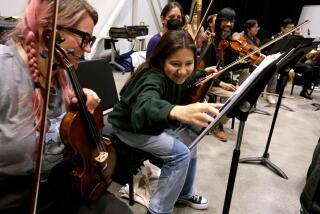A mesmerizing reminder of our place in the world
- Share via
The first sounds heard Friday night at UCLA’s Royce Hall came from the rear of the auditorium, not the venue’s spacious stage. Seeming to emerge from the distance, they approached rapidly -- the rumble and rattle of drums, the shimmer of cymbals -- finally bursting into full sonic blossom as members of the Japanese percussion ensemble Kodo made their way down the aisle. The procession instantly delineated Kodo’s belief that its drumming is an expression of community.
The 13 performers, all startlingly adroit percussionists, then came together in a series of tableaux, playing compositions reaching from the contemporary (artistic director Mitsuru Ishizuka’s “Ajara” ) to the traditional (“Mine-no-kaza”). Each piece was a study in aural and visual precision. Often starting with apparently basic 2/4 or 4/4 rhythms, the meters would shift into more complex combinations, as the drumming accents demanded ever greater virtuosity. Not only did the players deliver with ease, but they also did so in a flurry of synchronized drum strokes and choreographed movements.
At one point in the nearly two-hour performance, a small group of players interrupted the percussive waves with some whimsical visual gags. At another, concertgoers were enticed to clap with the rhythms.
But the most impressive moment arrived when a huge, wheeled platform was pushed onto the stage. On top was an enormous miya-daiko drum, carved from a single tree, measuring 4 feet across and weighing 800 pounds. Played in dramatically athletic fashion by a drummer on each side, its deep, powerful sounds, temblor-like in their effect, richly underscored the extraordinary power of the message at the heart of Kodo’s “One Earth Tour.”
The drum, according to many ethnomusicologists, was -- after the voice -- our first instrument, the first device to speak for a collective community, to marshal visceral energies, to extend the reach of communication and establish the organization of sound as an aesthetic act.
The members of Kodo, who live, train and work together as a collective on Japan’s Sado Island, have performed and toured for 25 years in an effort to remind audiences of their “membership in that much larger community: the world.” On Friday, that reminder was loud, clear and mesmerizing.
More to Read
The biggest entertainment stories
Get our big stories about Hollywood, film, television, music, arts, culture and more right in your inbox as soon as they publish.
You may occasionally receive promotional content from the Los Angeles Times.










